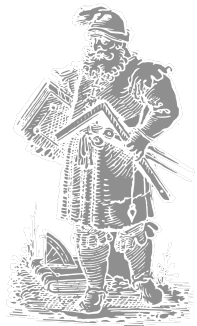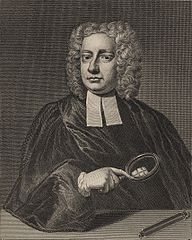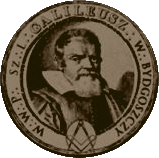The history of Freemasonry could be divided into three main periods: legendary, operative and speculative.
Legendary period - ancient freemasonry
 Like any other society, Freemasonry has its mythical period in which lie the roots from which the tradition is born. For the Masonic movement it is the time of Hiram Abiff of Tyre, the chief architect of King Hiram I. Hiram Abiff, as the chief builder was appointed to erect the Temple of Solomon in Jerusalem. He was a man of great knowledge and skills. According to legend, he knew the secret of the Grand Masonic Word, which is the symbol of the highest Knowledge and Excellence. Hiram promised that after the completion of the temple, he would pass the secret to their successors. Sorry, jealous and impatient workers tried to force the Hiram to earlier betrayal of the Great Word. When that did not work - the apprentices get restless and they murdered their master. Sacrifice of Hiram, a death suffered from the hand of greedy, envious and foolish people marked the beginning of Freemasonry.
Like any other society, Freemasonry has its mythical period in which lie the roots from which the tradition is born. For the Masonic movement it is the time of Hiram Abiff of Tyre, the chief architect of King Hiram I. Hiram Abiff, as the chief builder was appointed to erect the Temple of Solomon in Jerusalem. He was a man of great knowledge and skills. According to legend, he knew the secret of the Grand Masonic Word, which is the symbol of the highest Knowledge and Excellence. Hiram promised that after the completion of the temple, he would pass the secret to their successors. Sorry, jealous and impatient workers tried to force the Hiram to earlier betrayal of the Great Word. When that did not work - the apprentices get restless and they murdered their master. Sacrifice of Hiram, a death suffered from the hand of greedy, envious and foolish people marked the beginning of Freemasonry.
Operative period - guild (medieval) freemasonry
 Medieval tradition associated Freemasonry with the guild regime, in which the masters with apprentices gathered in guilds, guarding the secrets and professional interests. With regard to the "free masons" medieval, there are two terms: the guild and lodge. While the word guild is fairly widely recognized as the term structure of guilds, the word lodge refers to a workshop built temporarily in a larger construction project. This term appeared in 1278 in the Abbey of Vale Royal. Over time, the term began to be used for each meeting of architects (for example, records of such use can be found in the code of rights and obligations associated with the construction of the lodge in Minster Cathedral in 1352).
Medieval tradition associated Freemasonry with the guild regime, in which the masters with apprentices gathered in guilds, guarding the secrets and professional interests. With regard to the "free masons" medieval, there are two terms: the guild and lodge. While the word guild is fairly widely recognized as the term structure of guilds, the word lodge refers to a workshop built temporarily in a larger construction project. This term appeared in 1278 in the Abbey of Vale Royal. Over time, the term began to be used for each meeting of architects (for example, records of such use can be found in the code of rights and obligations associated with the construction of the lodge in Minster Cathedral in 1352).
A milestone in the history of Freemasonry was the Reformation. It was the first time in history when one challenged the monopoly of church power in determining the truth on such a large scale. For many people, it was a sign that it is possible to search for values beyond the rules imposed by the Catholic clergy. On the other hand, in countries where secularization of church property occured, disappearance of the funding role of the Church undermined the stone guilds stability.
At around this time, the royal legislation in England established the principle that each lodge should hire a secretary to document all transactions. In this way, the lodges were opened for people outside of the existing masonry industry. Some researchers believe that the next step was the adoption of the representatives of the rich aristocrat families, who provided protection for the lodge. Admission into the mysteries of Freemasonry of elite members of the society, resulted in a natural tendency to seek out new challenges - this time the intellectual and philosophical. Documents indicate that at about half of the seventeenth century, the majority of freemasons lodges were already specultative (involved in the spiritual and intellectual development rather than traditional engineering tasks).
Specultative freemasonry
 The process of transformation of operative lodges into specultative form never been thoroughly examined - mainly due to the Freemasonry confidentiality (which was a condition of employment in guilds and lodges of a new type). The specultative form of Freemasonry required some organisational means though. That's why representatives of the four most important Lodges, along with "several other brothers" met in 1717 in the famous tavern At Goose and Grate. The main animator of the reform was the son of French Huguenots settled in London, John Theophilus Desaguliers. He was a doctor of law, a physicist, a Fellow of the Royal Society and a close friend of Isaac Newton. Reforms were introduced shortly thereafter transcribed and preserved in the form of the famous Constitution of Anderson (1723). It is worth noting that the creator of the most important document of the Freemasons was a Christian preacher.
The process of transformation of operative lodges into specultative form never been thoroughly examined - mainly due to the Freemasonry confidentiality (which was a condition of employment in guilds and lodges of a new type). The specultative form of Freemasonry required some organisational means though. That's why representatives of the four most important Lodges, along with "several other brothers" met in 1717 in the famous tavern At Goose and Grate. The main animator of the reform was the son of French Huguenots settled in London, John Theophilus Desaguliers. He was a doctor of law, a physicist, a Fellow of the Royal Society and a close friend of Isaac Newton. Reforms were introduced shortly thereafter transcribed and preserved in the form of the famous Constitution of Anderson (1723). It is worth noting that the creator of the most important document of the Freemasons was a Christian preacher.
Over time, Masonic movement grew and strengthened. On the other hand, some internal differences occured, especially on the role of the power in society, the existence and definition of the Great Architect and the scope of human rights. Some of these things in question are topics that still discussed today. Modern Freemasonry has many paths that one can follow. Everyone can find their place here; those who are traditionalists and those who are more liberal.

